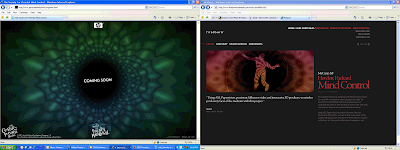 http://www.transphormetic.com/http://www.actionscript.com/flashweek/00000655.html
http://www.transphormetic.com/http://www.actionscript.com/flashweek/00000655.htmlComputational art with ActionScript
Posted by Paul Prudence, at 7/1/2004 - 11 comments
Click to view this author's website.
http://www.yugop.com/ Primitive artificial life forms, studies in fractal plant growth, interactive particle-clouds, user-controlled evolutionary acceleration and regeneration. Just as endless combinations of DNA code go towards describing our natural world, the Flash Artist instantiates behaviour into his building blocks of life, the movieclip, by becoming a biologist of computer code. ActionScript is a kind of DNA mnemonic to the Flash eco system, to be arranged as a blueprint for growth, behaviour and organisation. Hybrid algorithms spliced together from clippings of code -- hit F12 and watch your mutant code fill the browser with something quite unexpected and beautiful.
Optical colour-geometries reminiscent of Victor Vasarely's paintings, Internet data traffic maps, generative tessellations and strange attractors. Its not just about playing at God; with actionscript abstract mathematical equations that are meaningless on paper become a raw material to make a new kind of Art. Esoteric formulae become meaningful through their visualisation and we can finally appreciate their elegant symmetry and geometric beauty -- at last they begin to say something to us.
In 2002 an artist, Militos Manetas, and writer, Peter Lunenfeld, attracted some attention within the traditional art world by challenging the notion that large art establishments don’t really care much about art outside of physical space. Together they registered whitneybiennal.com and on it housed an exhibition to run concurrently with the internationally recognised Whitney Biennial. The exhibition was to contain net-art made entirely with Flash. Manetas cited two essays in explaining his reasons for choosing Flash. The first 'Generation Flash' by Lev Manovich looked at the phenomenon of Flash art and the creative energy of the community of artists that use it. The second, 'Flash is poptec' by Peter Lunenfeld, argues that Flash was "the irrepressible joy and lightness of being digital after the boom economy had gone bust."
Undoubtedly Whitneybiennial.com was a kind of milestone but artists that have been using actionscript way before 2002 may they be left wondering what all the fuss was about. Flash is an old timer on the taxonomy chart of computational net-art environments and many of these actionscript alchemists had been producing processor art since Flash 4 arrived.
In the late 90's Joshua Davis's Praystation.com set the benchmark standard in code. Together with Yugo Nakamura’s Yugop.com the limits of Flash were obliterated, rearranged and redefined. DuplicateMovieClip(), attachMovie() and recursive functions were chants of a new Actionscript-based cult. Nearly every artist using actionscript cites Joshua’s or Yugo’s work as the inspiration for getting started in the first place.
So how did a commercial application designed to produce 'compelling immersive marketing experiences' end up being used to produce computational art?
* Multidimensional Environment. The Flash authoring environment caters for animators, illustrators, and programmers alike. Flash provides complete synergy between drawing, animating and scripting never better illustrated than at Presstube.com. Flash is also a relatively easy programming environment to learn compared with its counterparts.
* Dedicated Community. The community that gathered around Flash has fostered a great cross-fertilisation and excitement of ideas. The open source model adopted by actionscripters has furthered inventiveness by allowing artists and designers to build on ideas already freely available, it allows artists to learn new techniques through inspection of each others code. Online competitions such as 5k and 25line contests have dared artists to visualise complexity through economy of file size and has a cyber-folk culture reminiscent of the computer graphics Demo scene.
* Ubiquity. Flash is ubiquitous across many platforms and is now built into browsers by default and works across different browsers without any fuss. The artist can avoid the asphyxiating culture of the art gallery in favour of the autonomy of the browser-space. This space has an everywhere-non-locality which means the art can be viewed anywhere a networked computer exists. The tiny Flash file sizes only further the propagation of Flash art through these networks.
A few years ago a Friends of ED published "Flash Math Creativity." This book wasn't aimed at commercial developers or laden with tutorials on how to build web applications. Instead it extolled the virtues of Flash as a creative tool and championed what business heads might call 'pointless flash'. Its premise was that with a little bit of code, some rudimentary math, and a lot of imagination you could make beautiful iterative art, and very addictive it could be too. A striking aspect was how many beautiful full-page colour pictures of the work it contained - less of a computer book, more coffee table art tome. It was a forward thinking approach and unfortunately nothing has been published like it since.
In the next instalment the author will take a closer look at the techniques and philosophies behind particular artworks made using actionscript.
Replies: 11 comments
1) good stuff. interesting read. will be back for pII
posted by scott (), 07/09/2004 06:18 AM CST
2) thanks
posted by immagini porno (), 07/14/2004 03:42 AM CST
3) thanks
posted by immagini erotiche (), 07/14/2004 03:46 AM CST
4) hello!
i have checked ur site.but one thing i like to know that,i dont no the basic languages, c or c++ etc., ilike to know the basic of flash, how to start a simple program like move a mouse on the image or any other thing to create some thing different.
thank you
posted by mamtha (), 07/30/2004 12:12 AM CST
5) hello mamtha,
i would first try having a look at the basic tuturials on some of the community sites out there.
http://www.flashkit.com/tutorials/Getting_Started/
http://www.were-here.com/homepage/featured.asp?zid=7
you can download examples and persue the source.
I would also thinK about investing in a good book and just dig-in.
we've all learnt a hell of a lot from colin moocks excellent book!
http://www.amazon.com/exec/obidos/tg/detail/-/059600396X/002-3770069-3947243?v=glance
posted by paul (), 07/30/2004 10:19 AM CST
6)
flow ITerator
genERa/t1v3
fluidiscence
express3nc3
5hittoleth
s4y sooth
zooph
maKe worldz
o Kreator design8











